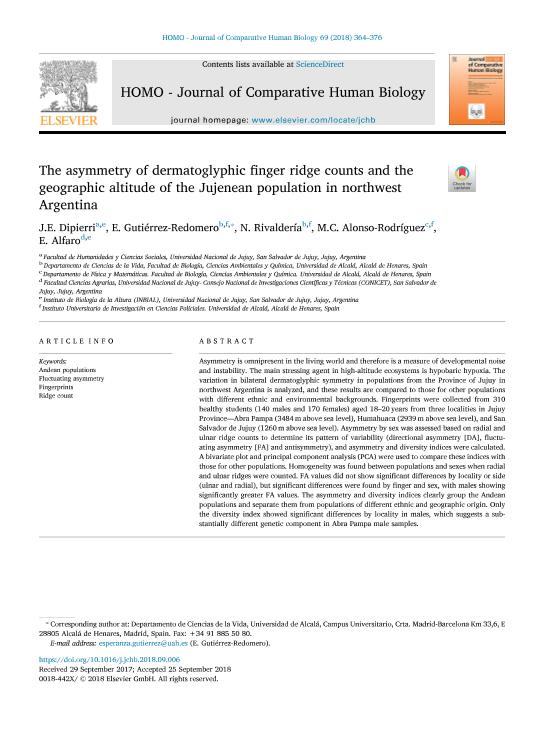Mostrar el registro sencillo del ítem
dc.contributor.author
Dipierri, Jose Edgardo

dc.contributor.author
Gutiérrez Redomero, E.
dc.contributor.author
Rivaldería, N.
dc.contributor.author
Alonso Rodríguez, M. C.
dc.contributor.author
Alfaro Gómez, Emma Laura

dc.date.available
2021-03-05T19:08:41Z
dc.date.issued
2018-11
dc.identifier.citation
Dipierri, Jose Edgardo; Gutiérrez Redomero, E.; Rivaldería, N.; Alonso Rodríguez, M. C.; Alfaro Gómez, Emma Laura; The asymmetry of dermatoglyphic finger ridge counts and the geographic altitude of the Jujenean population in northwest Argentina; Elsevier; HOMO; 69; 6; 11-2018; 364-376
dc.identifier.issn
0018-442X
dc.identifier.uri
http://hdl.handle.net/11336/127661
dc.description.abstract
Asymmetry is omnipresent in the living world and therefore is a measure of developmental noise and instability. The main stressing agent in high-altitude ecosystems is hypobaric hypoxia. The variation in bilateral dermatoglyphic symmetry in populations from the Province of Jujuy in northwest Argentina is analyzed, and these results are compared to those for other populations with different ethnic and environmental backgrounds. Fingerprints were collected from 310 healthy students (140 males and 170 females) aged 18–20 years from three localities in Jujuy Province—Abra Pampa (3484 m above sea level), Humahuaca (2939 m above sea level), and San Salvador de Jujuy (1260 m above sea level). Asymmetry by sex was assessed based on radial and ulnar ridge counts to determine its pattern of variability (directional asymmetry [DA], fluctuating asymmetry [FA] and antisymmetry), and asymmetry and diversity indices were calculated. A bivariate plot and principal component analysis (PCA) were used to compare these indices with those for other populations. Homogeneity was found between populations and sexes when radial and ulnar ridges were counted. FA values did not show significant differences by locality or side (ulnar and radial), but significant differences were found by finger and sex, with males showing significantly greater FA values. The asymmetry and diversity indices clearly group the Andean populations and separate them from populations of different ethnic and geographic origin. Only the diversity index showed significant differences by locality in males, which suggests a substantially different genetic component in Abra Pampa male samples.
dc.format
application/pdf
dc.language.iso
eng
dc.publisher
Elsevier

dc.rights
info:eu-repo/semantics/openAccess
dc.rights.uri
https://creativecommons.org/licenses/by-nc-sa/2.5/ar/
dc.subject
ANDEAN POPULATIONS
dc.subject
FINGERPRINTS
dc.subject
FLUCTUATING ASYMMETRY
dc.subject
RIDGE COUNT
dc.subject.classification
Genética y Herencia

dc.subject.classification
Ciencias Biológicas

dc.subject.classification
CIENCIAS NATURALES Y EXACTAS

dc.title
The asymmetry of dermatoglyphic finger ridge counts and the geographic altitude of the Jujenean population in northwest Argentina
dc.type
info:eu-repo/semantics/article
dc.type
info:ar-repo/semantics/artículo
dc.type
info:eu-repo/semantics/publishedVersion
dc.date.updated
2020-07-07T16:53:58Z
dc.journal.volume
69
dc.journal.number
6
dc.journal.pagination
364-376
dc.journal.pais
Países Bajos

dc.journal.ciudad
Amsterdam
dc.description.fil
Fil: Dipierri, Jose Edgardo. Universidad Nacional de Jujuy. Instituto de Biología de la Altura; Argentina. Universidad Nacional de Jujuy. Facultad de Humanidades y Ciencias Sociales; Argentina
dc.description.fil
Fil: Gutiérrez Redomero, E.. Universidad de Alcalá; España
dc.description.fil
Fil: Rivaldería, N.. Universidad de Alcalá; España
dc.description.fil
Fil: Alonso Rodríguez, M. C.. Universidad de Alcalá; España
dc.description.fil
Fil: Alfaro Gómez, Emma Laura. Universidad Nacional de Jujuy. Instituto de Ecorregiones Andinas. Consejo Nacional de Investigaciones Científicas y Técnicas. Centro Científico Tecnológico Conicet - Salta. Instituto de Ecorregiones Andinas; Argentina. Universidad Nacional de Jujuy. Instituto de Biología de la Altura; Argentina
dc.journal.title
HOMO
dc.relation.alternativeid
info:eu-repo/semantics/altIdentifier/doi/http://dx.doi.org/10.1016/j.jchb.2018.09.006
dc.relation.alternativeid
info:eu-repo/semantics/altIdentifier/url/https://www.sciencedirect.com/science/article/abs/pii/S0018442X18300568
Archivos asociados
